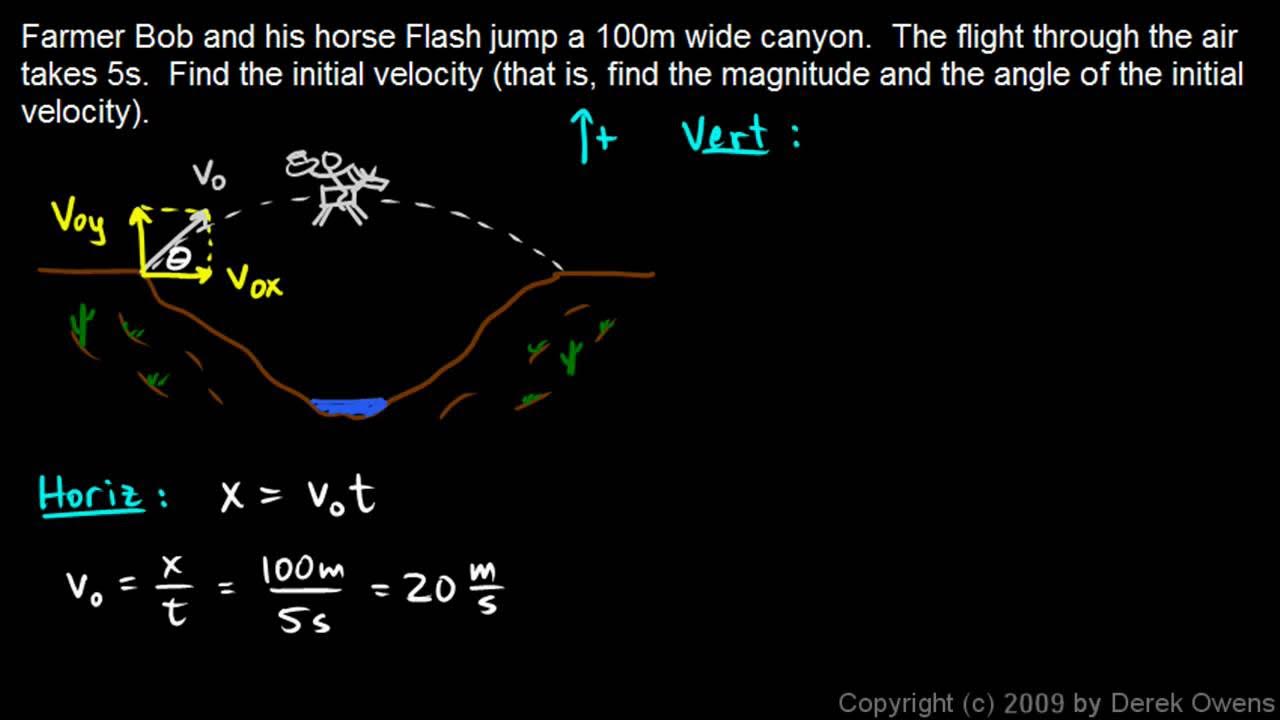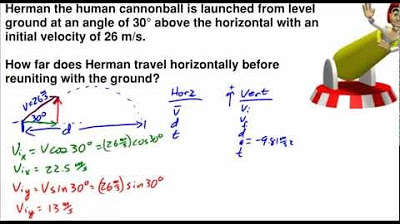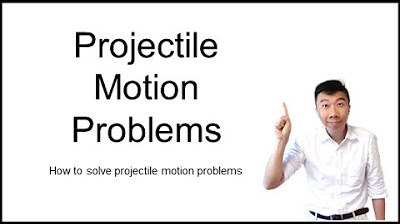Physics 3.5.4h - Projectile Practice Problem 8
TLDRThe video script explains a physics problem involving a football kicked at an angle of 38° above the horizontal with an initial velocity of 20 m/s. It details the process of solving the problem by separating it into horizontal and vertical components, neglecting air resistance for simplicity. The calculation shows that the football has a horizontal travel of 40 meters over a flight time of 2.51 seconds, using the equations of motion for projectile problems.
Takeaways
- 🏈 The problem involves a football kicked at an angle of 38° above the horizontal with an initial velocity of 20 m/s.
- 🚀 Air resistance is neglected in this problem, simplifying the calculation but acknowledging its significance in real-world scenarios.
- 📐 The horizontal and vertical components of the initial velocity (v0) are calculated using the cosine and sine of the angle, resulting in 15.8 m/s (horizontal) and 12.3 m/s (vertical).
- 🔢 The vertical motion is analyzed first to determine the time the football is in the air, using the equation of motion with the given initial vertical velocity and acceleration due to gravity (9.8 m/s²).
- 🕒 The time of flight (T) is calculated to be 2.51 seconds by solving the vertical motion equation, considering the initial and final heights to be zero.
- 🏁 The horizontal distance traveled by the football is determined by multiplying the horizontal velocity component (15.8 m/s) by the time of flight (2.51 seconds).
- 📐 The horizontal motion equation (x = v0x * T) is used to calculate the distance, without considering acceleration since it is zero in horizontal motion.
- 📊 The problem-solving approach is to solve the horizontal and vertical motions independently, which is a key strategy in projectile motion problems.
- 🎯 The importance of setting up the problem correctly is emphasized, as the positive and negative signs as well as units should work out when the equations are set up properly.
- 🔍 The script provides a step-by-step breakdown of the calculations, highlighting the process of solving for both the time of flight and the horizontal distance.
- 🌟 The final result of the problem is that the football travels a horizontal distance of 40 meters.
Q & A
What is the initial velocity of the football in the problem?
-The initial velocity of the football is 20 m/s at an angle of 38° above the horizontal.
How is air resistance considered in this problem?
-In this problem, air resistance is neglected. This is an idealized assumption often made in high school Physics courses to simplify calculations, even though in reality, air resistance can be significant for fast-moving footballs.
What are the horizontal and vertical components of the initial velocity?
-The horizontal component of the initial velocity (v0x) is 15.8 m/s, calculated as the initial velocity (20 m/s) times the cosine of the angle (38°). The vertical component of the initial velocity (v0y) is 12.3 m/s, calculated as the initial velocity times the sine of the angle.
What is the significance of solving projectile motion problems by separating horizontal and vertical motions?
-Separating the motions allows us to treat each component independently, simplifying the calculations. Since there is no acceleration in the horizontal direction (ignoring air resistance), the horizontal motion can be analyzed using constant velocity equations, while the vertical motion requires considering acceleration due to gravity.
How is the time of flight determined in the vertical motion?
-The time of flight is determined by setting the final vertical position to zero (since the ball returns to the ground) and using the kinematic equation for vertical motion: y = v0y * t - 0.5 * g * t^2. By rearranging the equation to solve for t and substituting the given values, we find that the total time of flight is 2.51 seconds.
What is the horizontal distance the football travels during its flight?
-The horizontal distance traveled is 40 meters, calculated by multiplying the horizontal velocity (15.8 m/s) by the time of flight (2.51 seconds).
Why is it important to use the correct units and signs in the equations?
-Using the correct units ensures that the calculations are dimensionally consistent and that the final answer has the proper physical units. Properly handling signs is crucial for representing direction (positive for upward motion and negative for acceleration due to gravity) and ensuring that the equations accurately model the physical situation.
What is the acceleration considered in the vertical motion?
-The acceleration considered in the vertical motion is the acceleration due to gravity, which is -9.8 m/s^2. It is negative because it acts downward, opposite to the positive direction defined by the upward initial velocity.
How does the horizontal component of the initial velocity affect the overall motion of the football?
-The horizontal component of the initial velocity determines the distance the football travels along the ground before landing. Since there is no horizontal acceleration, the horizontal velocity remains constant, and the football travels in a straight line parallel to the ground.
What would be the impact of including air resistance in the calculations?
-Including air resistance would make the problem more complex and the football's trajectory less parabolic. The horizontal range would likely be reduced, and the time of flight could be affected. Air resistance would also cause the football to lose speed more quickly, altering the magnitude of both the horizontal and vertical components of velocity.
How does the initial angle of the football's velocity affect the range of the projectile?
-The initial angle affects the range by determining the balance between the horizontal and vertical components of the velocity. An angle of 45° would maximize the range for a given initial speed, as it equally distributes the velocity into the horizontal and vertical directions without any component being wasted.
Outlines
🏈 Projectile Motion - Initial Conditions and Assumptions
This paragraph introduces a physics problem involving a football kicked at an angle of 38° above the horizontal with an initial velocity of 20 m/s. The problem assumes no air resistance, which is an idealization often used in high school physics to simplify calculations. The key to solving projectile motion problems is to analyze the horizontal and vertical components separately. The horizontal component (v0x) is calculated as the initial velocity times the cosine of the angle, resulting in 15.8 m/s, while the vertical component (v0y) is the initial velocity times the sine of the angle, resulting in 12.3 m/s. The approach to solving the problem involves first determining the time the football is in the air using the vertical motion and then using this time to calculate the horizontal distance traveled.
🕒 Calculating Time of Flight and Horizontal Distance
The second paragraph delves into the calculation of the time of flight for the football using its vertical motion. By setting the initial and final heights to zero and applying the kinematic equation for displacement, the time (T) is determined to be 2.51 seconds. With the time of flight established, the horizontal distance is then calculated using the horizontal component of the initial velocity (15.8 m/s) and the time of flight. The result is a horizontal travel distance of 40 meters. This step-by-step approach demonstrates how to apply the principles of projectile motion to find both the time in the air and the horizontal distance traveled by the football.
Mindmap
Keywords
💡Projectile Motion
💡Initial Velocity
💡Angle of Projection
💡Horizontal Component
💡Vertical Component
💡Acceleration due to Gravity
💡Time of Flight
💡Horizontal Distance
💡Air Resistance
💡Parabolic Trajectory
Highlights
The problem involves a football kicked at an angle above the horizontal with a given initial velocity.
The football's motion is parabolic, and air resistance is neglected for simplicity.
The horizontal component of the initial velocity is calculated using the cosine of the angle.
The vertical component of the initial velocity is determined using the sine of the angle.
The key to solving projectile motion problems is to analyze the horizontal and vertical motions independently.
The vertical motion is used to find the time the football spends in the air.
The equation for vertical motion is derived and solved for time of flight.
The horizontal distance is calculated using the horizontal velocity and the time found from the vertical motion.
The football's total flight time is determined to be 2.51 seconds.
The horizontal distance traveled by the football is calculated to be 40 meters.
The approach to solving the problem involves a step-by-step method, first vertical then horizontal.
The problem assumes a positive direction for the vertical velocity component.
The initial and final heights are considered to be zero for the calculation of time.
The horizontal motion has no acceleration, and the initial velocity remains constant throughout.
The problem demonstrates the application of kinematic equations in analyzing projectile motion.
The process of solving the problem is engaging and educational, suitable for high school physics students.
Transcripts
Browse More Related Video

Projectile Launched of a Cliff

Physics 3.5.4b - Projectile Practice Problem 2

Regents Physics: Angled Projectile Problem Practice

Projectile at an angle | Two-dimensional motion | Physics | Khan Academy

AP Physics B Kinematics Presentation General Problems #11

Consolidation: Projectile Motion Calculations
5.0 / 5 (0 votes)
Thanks for rating: